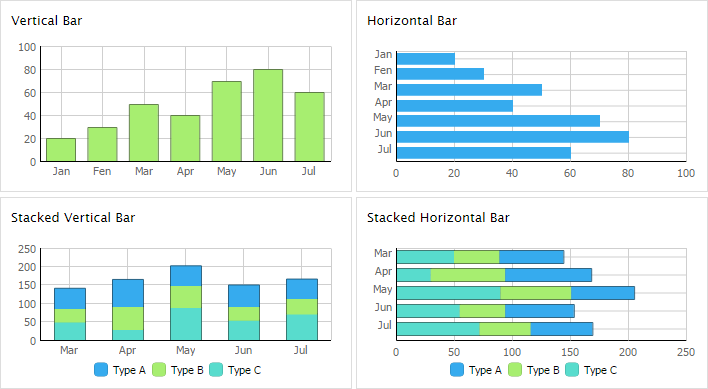Bar Chart
Bar chart is the most common chart type to present data. It's used to compare two or more values and show their relative quantities.
DhtmlxChart gives you full scope for Bar Chart creation and offers the next sub-types of Bar Chart:
- Vertical Bar
- Horizontal Bar
- Stacked Vertical Bar
- Stacked Horizontal Bar

Now let’s start to create a Bar Chart yourself step by step.
It will be a simple Bar Chart which you can improve at any time just adding additional functions and properties.
First, we need to make some preparatory steps.
1) Decide what data you want to display. It can have different formats. In our examples we use Sales Information of one little company in JSON format.
var data = [
{ sales:3.8, year:"2001" },
{ sales:3.4, year:"2002" },
…
{ sales:4.8, year:"2009" }
];
2) Insert to your page an HTML container for your future chart with the name "chart_container", for instance.
<div id="chart_container" style="width:280px;height:250px;border:1px solid #A4BED4;"></div>
Now, we are ready to fill in an object constructor. Just make the next step to know the details.
3) Set chart type depending on the sub-type you have chosen.
Vertical Bar - "bar"
Horizontal Bar - "barH"
Stacked Vertical Bar - "stackedBar"
Stacked Horizontal Bar - "stackedBarH"
We will create classic vertical bar, so in the property 'view' we'll specify the value "bar".
var barChart = new dhtmlXChart({
view:"bar"
....
})
4) Define 'chart_container' in the ‘container’ property to set chart container.
var barChart = new dhtmlXChart({
view:"bar",
container:"chart_container"
...
})
5) Assign '#sales#' to the ‘value’ property to set data that Bar Chart will present.
var barChart = new dhtmlXChart({
view:"bar",
container:"chart_container",
value:"#sales#",
...
})
Other parameters are optional, choose them according to your needs.
6) Select a bar color. For example, set value '#66cc33' (green color). Learn more about chart color here.
var barChart = new dhtmlXChart({
view:"bar",
container:"chart_container",
value:"#sales#",
color:"#66cc33"
...
})
7) Set bar width e.g. value '30'.
var barChart = new dhtmlXChart({
view:"bar",
container:"chart_container",
value:"#sales#",
color:"#66cc33",
width:30
...
})
8) Assign value '#year#' to the ‘tooltip’ property of an object constructor to set bar tooltip. Learn more about chart tooltip here.
var barChart = new dhtmlXChart({
view:"bar",
container:"chart_container",
value:"#sales#",
color:"#66cc33",
width:30,
tooltip: "#year#"
...
})
We've almost finished. A little patience. Scale is left.
9) Name xAxis and choose scale data (parameter 'template'). In the example we will use the following values:'#Sales per year#' as xAxis name and '#year#' as scale data. Learn more about chart scale here.
var barChart = new dhtmlXChart({
view:"bar",
container:"chart_container",
value:"#sales#",
color:"#66cc33",
width:30,
tooltip: "#year#",
xAxis:{
title:"Sales per year",
template:"#year#"
}
...
})
xAxis is completed. Next in turn - yAxis.
10) Name scale and define scale data as well. Also set start, end positions and scale step. We will name the yAxis - '#Sales,mil#' and set the following values:start - '3', end - '9', step - '3'. Data value is '{obj}'. Learn more about chart scale here.
var barChart = new dhtmlXChart({
view:"bar",
container:"chart_container",
value:"#sales#",
color:"#66cc33",
width:30,
tooltip: "#year#",
xAxis:{
title:"Sales per year",
template:"#year#"
},
yAxis:{
start:3,
end:9,
step:3,
template:"{obj}",
title:"Sales,mil"
}
})
11) Use method parse() to process data.
barChart.parse(data,"json");
We've finished. Just run the application to see your creation.
If you want to represent several data properties on the chart - use the addSeries() method.

The addSeries() method in details and in the following example:
Series margin and padding in Bar chart
It's possible to customize margin and padding of series in Vertical and Horizontal Bar charts. You just need to specify the following parameters and set the needed values for them:
- seriesPadding - (number) the space between groups of bars
- seriesMargin - (number) the space between bars within one series group
var chart = new dhtmlXChart({
view: "bar",
seriesPadding: 5,
seriesMargin: 2,
...
});
chart.addSeries(...);
The examples of Bar Chart sub-types are presented below:
Related sample: Initialization
Related sample: Horizontal Bars
Related sample: Stacked Horizontal Bars
Back to top